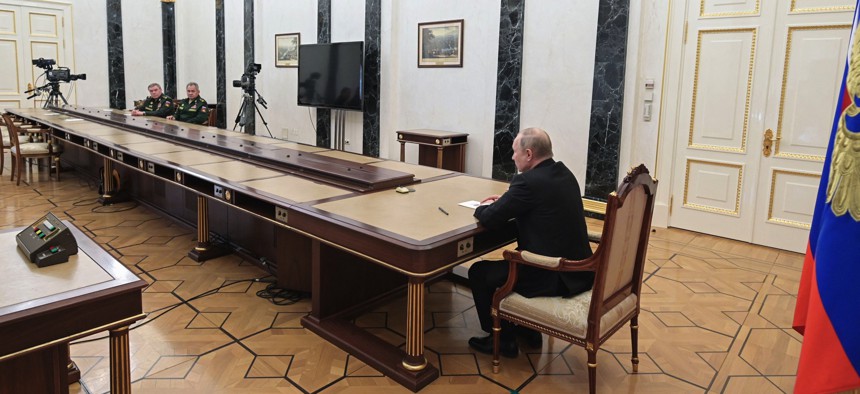
Russian leader Vladimir Putin meets with Defence Minister Sergei Shoigu and chief of the general staff Valery Gerasimov in Moscow on February 27, 2022. ALEXEY NIKOLSKY/SPUTNIK/AFP via Getty Images
What Just Happened With Putin’s Nuclear Forces? Here’s What Experts Say
Whatever it is, U.S. officials are calling it escalatory–but not “high alert.”
Even expert Russia-watchers aren’t sure what changed when Vladimir Putin ordered the country’s “deterrence forces” to be put on a “special regime of combat duty” on Sunday.
A U.S. defense official who spoke to reporters on Sunday called the move “escalatory” but declined to offer more details. Many news organizations interpreted the order as placing Russia’s nuclear weapons units on a higher state of alert.
Several experts said that Putin’s order might have been most directly about nuclear command-and-control.
“We’ve never heard announcements like that before,” said Pavel Podvig, a senior researcher with the United Nations Institute for Disarmament Research, or UNIDIR. “I don’t have absolute certainty what it means. My best guess is that he was referring to the way the command-and-control systems operate.
“The way I believe it works, and the way it’s supposed to work, is that normally, under the day-to-day status, the system is not capable of transmitting orders” to launch nuclear weapons, Podvig said in an interview with Defense One. “But you can bring it into the status where it is capable.”
A command-and-control shift is one possibility, said James Acton, who co-directs the Nuclear Policy Program at the Carnegie Endowment for International Peace. In an interview, he said he believes the increased alert is for a select group of people and units, and possibly not even for all of Russia's nuclear forces.
Acton noted that there are many other steps required for nuclear use that may or may not be announced. He laid out some of them in an earlier Twitter thread, including warheads for non-strategic systems being moved out of centralized storage and mobile ICBMs being dispersed. And he said U.S. intelligence officials are probably monitoring Russia’s nuclear forces for visible changes.
While the likelihood of use of nuclear weapons is still fairly small, it is now higher than a few weeks ago, Acton said.
“So this is unusual. This hasn't happened for a long time. And that's concerning,” he said.
The last time nuclear alert levels were raised by the United States or Russia or the Soviet Union was 48 years ago, when the U.S. raised its level during the Yom Kippur War.
Adding to the uncertainty, it’s unclear what Western reaction Putin hoped to provoke with the announcement, Acton said. Putin said Sunday that he was reacting to sanctions imposed on Russia and “aggressive statements” made by Western governments.
“I don't know that he knows exactly what he wants us to do in his own mind. And that's kind of concerning for me,” Acton said. “I do think we have to try and find a face-saving way for Putin to extricate himself from this crisis.”
Defense Secretary Lloyd Austin was in a scheduled meeting with Joint Chiefs Chairman Gen. Mark Milley, head of U.S. European Command Gen. Tod Wolters and others when they heard Putin’s announcement of the heightened nuclear forces posture, a senior defense official told reporters on Sunday.
The official would not say whether the United States had made any changes to its own posture in response, and called Putin’s actions “escalatory.”
“It's clearly potentially putting into play forces that could, that if there's a miscalculation, could make things much, much more dangerous,” the official said.
Asked about any change to U.S. posture, the official said, “I would just tell you that we remain confident in our ability to defend ourselves and our allies and our partners, and that includes in the strategic deterrent realm, and that is as far as I'm going to go on that question.”
Podvig said the main danger is of an escalatory spiral, and he said other countries should refrain from nuclear signaling of their own.
“In my view, the response to that should be a forceful and clear message from everyone, not just the U.S. or nuke-power states, that this is not acceptable, waving your nuclear forces like that, it should not be done, under any circumstances,” he said.
That was the kind of message sent on Sunday morning by Linda Thomas-Greenfield, U.S. ambassador to the United Nations, who called the alert a "totally unacceptable" escalation of Russians aggression against Ukraine.
In contrast, Podvig called a Thursday statement by French Foreign Minister Jean-Yves Le Drian—”I think that Vladimir Putin must also understand that the Atlantic alliance is a nuclear alliance”—”exactly the wrong kind of message.”



